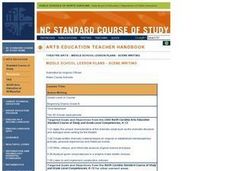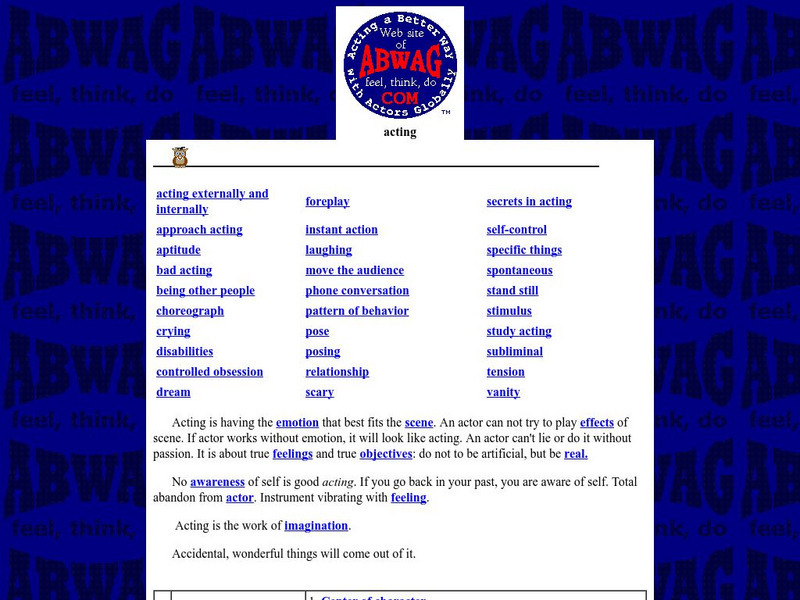Curated OER
Playing with Puns
"O pun" the door on this activity. Have your pupils compare the puns and word play in scenes from Shakespeare’s Twelfth Night to those in Gary Blackwood’s The Shakespeare Stealer. Warm up and introductory activities, as well as...
Curated OER
Creepy Crawly Book Reports
Students read a book and identify a key character or scene to portray in a unique book report format. They sculpt a character or scene from the book around an armature and label it. Students write a report and commentary about their book...
Curated OER
Drama Terms Notes
Comedy, tragedy, act, scene, prop. do you want to review important drama terms? Actors record the term next to its definition on a worksheet that could be used individually or as a group activity. A link to a corresponding PowerPoint...
Curated OER
Scene Writing
Eighth graders create an original scene or short one-act play within specified guidelines. Assessment is based upon the performance of student-created scenes during class time. Rubrics for assessment and connection to state standards...
Curated OER
Lights, Camera, Action...Crossing the Delaware in 9 Scenes
How does reading a drama differ from reading a novel? Middle schoolers become playwrights and explore these differences. After viewing the A&E movie,"The Crossing," groups create stage directions, write dialogue, and design sets and...
Curated OER
Writing a Tall Tale
Students investigate tall tales. In this tall tales lesson, students read tall tales, then write their own. Students focus on writing about exciting character development, plots, and scenes. Students edit and revise their papers before...
Curated OER
Writing Fiction lesson plan
Students compose a opening paragraph that sets the scene and foreshadows events. In this writing fiction lesson, students write an opening paragraph about a mugging and describe the scene in a way that foreshadows something bad is...
Curated OER
Using Visual Art to Create Scenes
High schoolers review scene structure and the elements beginning, middle and end. They view a piece of art to stimulate an idea for a improvised scene. Students work in small groups, create and then perform their scenes for the rest of...
Curated OER
Literature Response for Home-School Connections:
First graders explore learning skills that can be practiced at home in the ten lessons of this unit. Oral reading, letter formation, fairy tale identification, and phonic awareness exercises are provided in this unit.
Curated OER
What? Did Caesar Swoon?
Students discover the "dumb show," a scene that enacts a story silently while focusing on an example from Hamlet. Divided into groups, they act out the silent scene from the play. Again, in groups, they create a "dumb show" from Julius...
Better Lesson
Better Lesson: Rl.3.5: Refer to Parts of Stories, Dramas, and Poems
Links to 73 lessons that focus on skills within third grade reading standard RL.3.5.
Folger Shakespeare Library
Folger Shakespeare Library: Lesson Plan Archive: Hero vs. Claudio
What do you know about marriage customs during the English Renaissance? Students will have an opportunity to learn about weddings and marriages in Renaissance English using "Much Ado About Nothing" as source material.
University of Alberta
Eas: A Gallery of 19th Century Icelandic Landscape Art
This website provides images of 19th century landscapes of various parts of Iceland. Images links to larger images for viewing purposes.
Varsity Tutors
Varsity Tutors: Web English Teacher: William Shakespeare: As You Like It
For William Shakespeare's comedy As You Like It, this site is linked to lesson plans and teaching materials, articles, introductory and background resources and the like.
Caro Clarke
Explaining Too Much: Why More Is Less
This is the eleventh article in a series that is designed to help the new novel author. This article focuses on how to eliminate needless information in your novel. The key is to not explain too much about the action.
Other
Fiction Writing Tips: Creating a Vivid Setting
Some excellent guidelines to consider when evaluating your setting in a short story or novel. Discusses the importance of setting, some examples, as well as practical advice in setting your story. W.11-12.3d Sensory/precise lang narratives
Other
Writing World: Four Ways to Bring Settings to Life
A great resource outlining four major ways to make settings appear more real and genuine in fiction. Deals with themes such as motion, experience, mood, and the senses. W.11-12.3d Sensory/precise lang narratives
Other
Fiction Factor: The Importance of Setting
An interesting article concerning the importance of setting to any piece of fiction. Gives good information about how setting affects characters and "world-building."
Louisiana Department of Education
Louisiana Doe: Curriculum Hub: Ela Guidebooks: Romeo and Juliet: Compare to Film Adaptation
Students view minute 23 to minute 34 from Romeo and Juliet (Luhrmann) to determine what could be added to or changed about this scene by the director.
ArtLex
Art Lex: Landscape
A very nice website with a definition of landscape and several examples of landscape paintings and photographs. Provides links to landscape art from specific historical eras.
ArtLex
Art Lex: Pastoral Art
This website describes a specific type of landscape, the pastoral. Includes several examples of pastoral scenes and links to further information on the individual pieces of artwork.
Emory University
Emory University: "As You Like It"
Clickable list of paintings inspired by scenes in Shakespeare's "As You Like It" with text.
Emory University
Emory University: Much Ado About Nothing
This site from the Emory University provides a link to an illustration from Shakespeare's "Much Ado About Nothing."
Other
Abwag: Learn About Acting
Student awareness and appreciation of acting will be enhanced after discovering the tricks of the trade. They will learn how to act, feel and think in an acting environment.




















